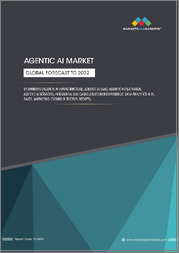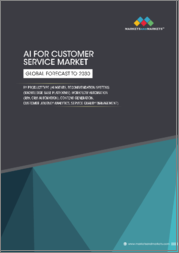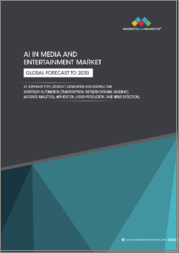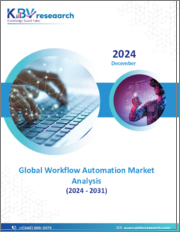
|
시장보고서
상품코드
1744590
세계의 워크플로우 자동화 시장 : 구성 요소별, 전개 모델별, 조직 규모별, 용도별, 최종 사용자별, 지역별 분석, 예측(-2032년)Workflow Automation Market Forecasts to 2032 - Global Analysis By Component (Software and Services), Deployment Model, Organization Size, Application, End User and By Geography |
||||||
Stratistics MRC에 따르면 세계 워크플로우 자동화 시장은 2025년에 246억 달러, 예측 기간 동안 CAGR은 11.7%를 나타내고 2032년에는 534억 달러에 이를 것으로 예측됩니다.
워크플로우 자동화는 효율성, 정확성 및 생산성을 향상시키기 위해 비즈니스 워크플로우 내에서 반복적인 수동 작업을 자동화하는 기술을 사용하는 프로세스입니다. 재무, 인사, 고객 서비스 등의 분야에서 일반적인 워크플로우의 자동화는 오류를 줄이고 업무 속도를 높이고 일관성을 보장합니다.
세계경제포럼에 따르면 RPA나 AI 등의 기술을 재빨리 채용한 기업에서는 시장 투입까지의 시간이 30%-90% 단축되어 공장 생산고가 최대 200% 향상된 것으로 보고되었습니다.
업종을 넘어 IoT 채용 확대
다양한 섹터에서 IoT 디바이스가 광범위하게 통합됨에 따라 워크플로우 자동화 수요가 크게 늘어나고 있습니다. 데이터를 기반으로 작업을 구성하는 자동화의 능력은 중요한 추진력입니다.
높은 초기 도입 비용
워크플로우 자동화 솔루션을 도입하려면 많은 투자가 필요하기 때문에 잠재적인 사용자는 주저합니다. 이에 맞추어 솔루션을 맞춤화하는 복잡성은 재정 지출에 박차를 가할 수 있습니다.
고객 경험에 대한 관심 증가
고객 경험을 향상시키는 기업이 늘어나고 있으며, 워크플로우 자동화의 도입이 진행되고 있습니다. 이러한 CX 중심의 자세는 원활하고 일관된 고객 여정을 실현하는 솔루션에 대한 투자를 촉구합니다. 수작업으로 인한 오류와 지연을 없애면서 자동화는 보다 안정적이고 긍정적인 고객 대응에 기여합니다.
사이버 보안 위험
워크플로우 자동화로 인한 상호 연결성이 커지면 사이버 보안에 심각한 취약점이 생길 수 있습니다. 대책이 필요합니다. 악의적인 행위자가 자동화의 허점을 악용할 가능성은 큰 리스크를 가져옵니다.
COVID-19의 영향 :
COVID-19의 대유행은 기업이 업무상의 회복력을 요구하여 워크플로우 자동화의 도입을 크게 가속시켰습니다. 원격 근무 의무화로 인해 비즈니스 연속성과 직원 협업을 유지하기 위해 자동화된 프로세스가 필요했습니다.
예측 기간 동안 소프트웨어 부문이 최대가 될 전망
소프트웨어 부문은 고급 자동화 플랫폼에 대한 수요가 증가함에 따라 예측 기간 동안 최대 시장 점유율을 차지할 것으로 예측됩니다. 클라우드 기반 자동화 소프트웨어로의 전환은 시장 지배력에 더욱 기여하고 있습니다. 이 소프트웨어 솔루션의 사용자 정의 옵션과 통합 기능은 매우 요구되고 있습니다.
예측 기간 동안 온프레미스 부문이 가장 높은 CAGR이 예상됩니다.
예측 기간 동안 데이터 보안 및 컴플라이언스 요구 사항이 증가함에 따라 온프레미스 부서가 가장 높은 성장률을 보일 것으로 예측됩니다. 기존의 견고한 IT 인프라를 갖춘 기업은 장기적으로 온프레미스 솔루션이 더 비용 효율적이라고 생각합니다. 또, 하드웨어와 소프트웨어를 직접 제어할 필요가 있는 커스터마이즈 된 솔루션이 선호되는 것도, 이 성장의 일인이 되고 있습니다.그 때문에 보안과 제어에의 배려가, 온프레미스형 워크플로우 자동화의 성장을 강하게 추진하고 있습니다.
최대 점유율을 차지하는 지역
예측 기간 동안 아시아태평양은 급속한 디지털 변환에 대한 이니셔티브와 비즈니스 복잡성으로 인해 가장 큰 시장 점유율을 차지할 것으로 예측됩니다. 성장은 자동화 수요를 촉진하고 있습니다. 전자상거래 부문의 활황과 공급망의 최적화 요구도 시장을 견인하고 있습니다.
CAGR이 가장 높은 지역 :
예측기간 동안 북미지역이 가장 높은 CAGR을 나타낼 것으로 예측됩니다. 그리고 지능형 자동화 솔루션에 대한 수요 증가는 이 지역에서 특히 두드러집니다.
무료 주문을 받아서 만드는 서비스 :
이 보고서를 구독하는 고객은 다음 무료 맞춤설정 옵션 중 하나를 사용할 수 있습니다.
- 기업 프로파일
- 추가 시장 기업의 종합적 프로파일링(3개사까지)
- 주요 기업의 SWOT 분석(3개사까지)
- 지역 세분화
- 고객의 관심에 응한 주요국 시장 추정, 예측 및 CAGR(주 : 타당성 확인에 따름)
- 경쟁 벤치마킹
- 제품 포트폴리오, 지리적 존재, 전략적 제휴에 기반한 주요 기업 벤치마킹
목차
제1장 주요 요약
제2장 서문
- 개요
- 이해관계자
- 조사 범위
- 조사 방법
- 데이터 마이닝
- 데이터 분석
- 데이터 검증
- 조사 접근
- 조사 자료
- 1차 조사 자료
- 2차 조사 정보원
- 전제조건
제3장 시장 동향 분석
- 성장 촉진요인
- 억제요인
- 기회
- 위협
- 용도 분석
- 최종 사용자 분석
- 신흥 시장
- COVID-19의 영향
제4장 Porter's Five Forces 분석
- 공급기업의 협상력
- 구매자의 협상력
- 대체품의 위협
- 신규 참가업체의 위협
- 경쟁 기업간 경쟁 관계
제5장 세계의 워크플로우 자동화 시장 : 구성 요소별
- 소프트웨어
- 로봇식 프로세스 자동화(RPA)
- 비즈니스 프로세스 관리(BPM)
- AI 구동형 자동화
- 서비스
- 구현 및 통합
- 컨설팅
- 지원 및 유지 보수
제6장 세계의 워크플로우 자동화 시장 : 전개 모델별
- On-Premise
- 클라우드
제7장 세계의 워크플로우 자동화 시장 : 조직 규모별
- 대기업
- 중소기업
제8장 세계의 워크플로우 자동화 시장 : 용도별
- 인사
- 재무와 회계
- 판매 및 마케팅
- 고객 서비스
- 기타 용도
제9장 세계의 워크플로우 자동화 시장 : 최종 사용자별
- BFSI
- IT 및 통신
- 헬스케어
- 제조업
- 기타 최종 사용자
제10장 세계의 워크플로우 자동화 시장 : 지역별
- 북미
- 미국
- 캐나다
- 멕시코
- 유럽
- 독일
- 영국
- 이탈리아
- 프랑스
- 스페인
- 기타 유럽
- 아시아태평양
- 일본
- 중국
- 인도
- 호주
- 뉴질랜드
- 한국
- 기타 아시아태평양
- 남미
- 아르헨티나
- 브라질
- 칠레
- 기타 남미
- 중동 및 아프리카
- 사우디아라비아
- 아랍에미리트(UAE)
- 카타르
- 남아프리카
- 기타 중동 및 아프리카
제11장 주요 발전
- 계약, 파트너십, 협업, 합작투자
- 인수와 합병
- 신제품 발매
- 사업 확대
- 기타 주요 전략
제12장 기업 프로파일링
- Amazon Web Services(AWS)
- Blue Prism Group plc
- IBM Corporation
- Microsoft Corporation
- Oracle Corporation
- Pegasystems Inc.
- SAP SE
- TIBCO Software Inc.
- Xerox Corporation
- Zoho Corporation
- Appian Corporation
- Bizagi
- Software AG
- IPsoft Inc.
- Nintex Global Limited
According to Stratistics MRC, the Global Workflow Automation Market is accounted for $24.6 billion in 2025 and is expected to reach $53.4 billion by 2032 growing at a CAGR of 11.7% during the forecast period. Workflow automation is the process of using technology to automate repetitive, manual tasks within a business workflow to improve efficiency, accuracy 6y, and productivity. It involves the integration of software tools and systems that manage tasks, data routing, approvals, and notifications without human intervention. Common in sectors like finance, HR, and customer service, workflow automation reduces errors, speeds up operations, and ensures consistency. By streamlining processes, organizations can focus on higher-value activities and enhance overall operational performance and decision-making capabilities.
According to the World Economic Forum, early adopters of technologies such as RPA and AI reported 30%-90% faster time to market and up to 200% higher factory output.
Market Dynamics:
Driver:
Increasing Adoption of IoT Across Industries
The widespread integration of IoT devices across various sectors is significantly boosting the demand for workflow automation. These connected devices generate vast amounts of data, necessitating automated processes for efficient analysis and action. The ability of automation to orchestrate tasks based on real-time IoT data is a key driver. Enterprises are recognizing the immense value of automating workflows to manage the complexity of IoT deployments. Furthermore, the interoperability between IoT platforms and automation tools is becoming increasingly sophisticated.
Restraint:
High Initial Implementation Costs
The significant upfront investment required for adopting workflow automation solutions can deter potential users. Companies often face substantial expenses related to software licenses, hardware upgrades, and integration with existing systems. Furthermore, the complexity of customizing solutions to specific organizational needs can add to the financial outlay. The long-term return on investment, while promising, often requires a considerable initial financial commitment. Therefore, budget constraints can pose a significant barrier to entry for many organizations.
Opportunity:
Increased Focus on Customer Experience
Businesses are increasingly prioritizing an enhanced customer experience, driving the adoption of workflow automation. Automation allows for quicker response times and personalized interactions, leading to greater customer satisfaction. Companies are leveraging automated communication and service workflows to build stronger customer relationships. This focus on CX encourages investments in solutions that ensure seamless and consistent customer journeys. By eliminating manual errors and delays, automation contributes to a more reliable and positive customer interaction. Therefore, improving the overall customer experience is a powerful motivator for market growth.
Threat:
Cybersecurity Risks
The increasing interconnectedness brought by workflow automation introduces significant cybersecurity vulnerabilities. Automated systems, if compromised, can provide attackers with widespread access to critical data and processes. Protecting these intricate systems from evolving cyber threats requires continuous vigilance and advanced security measures. The potential for malicious actors to exploit automation loopholes presents a substantial risk. Furthermore, ensuring the integrity and confidentiality of automated data flows is a paramount concern for organizations. The complex nature of these systems often makes them attractive targets for sophisticated cyberattacks.
Covid-19 Impact:
The COVID-19 pandemic significantly accelerated the adoption of workflow automation as businesses sought operational resilience. Remote work mandates necessitated automated processes to maintain business continuity and employee collaboration. Companies leveraged automation to manage increased demand, supply chain disruptions, and evolving customer needs. The pandemic spurred digital transformation initiatives across industries, with workflow automation as a cornerstone. Consequently, the COVID-19 era firmly established automation as an essential component of modern business operations.
The software segment is expected to be the largest during the forecast period
The software segment is expected to account for the largest market share during the forecast period, driven by the increasing demand for advanced automation platforms. Furthermore, the flexibility and scalability offered by software-based automation appeal to a wide range of enterprises. The shift towards cloud-based automation software further contributes to its market dominance. Customization options and integration capabilities of these software solutions are highly sought after. Therefore, the essential role of software in enabling comprehensive workflow automation ensures its leading position.
The on-premises segment is expected to have the highest CAGR during the forecast period
Over the forecast period, the on-premises segment is predicted to witness the highest growth rate, due to heightened data security and compliance requirements. Furthermore, specific legacy systems often necessitate on-premises deployments for seamless integration. Enterprises with existing robust IT infrastructure find on-premises solutions more cost-effective in the long run. The preference for customized solutions that require direct control over hardware and software also contributes to this growth. Therefore, security and control considerations are strongly propelling the growth of on-premises workflow automation.
Region with largest share:
During the forecast period, the Asia Pacific region is expected to hold the largest market share, owing to its rapid digital transformation initiatives and growing business complexities. The substantial growth in manufacturing and IT sectors across countries like China and India fuels the demand for automation. The booming e-commerce sector and the need for optimized supply chains also drive the market. Consequently, the combination of technological embrace and economic growth positions Asia Pacific as the leading market.
Region with highest CAGR:
Over the forecast period, the North America region is anticipated to exhibit the highest CAGR, attributed to the strong presence of key technology providers and early adoption of advanced automation solutions. Furthermore, the emphasis on improving operational efficiency and reducing labor costs across industries is a major growth driver. The increasing demand for robotic process automation (RPA) and intelligent automation solutions is particularly strong in this region. Robust venture capital funding for automation startups also contributes to this accelerated growth. Therefore, the combination of technological leadership and a proactive business environment propels North America's rapid market expansion.
Key players in the market
Some of the key players in Workflow Automation Market include Amazon Web Services (AWS), Blue Prism Group plc, IBM Corporation, Microsoft Corporation, Oracle Corporation, Pegasystems Inc., SAP SE, TIBCO Software Inc., Xerox Corporation, Zoho Corporation, Appian Corporation, Bizagi, Software AG, IPsoft Inc., and Nintex Global Limited.
Key Developments:
In May 2025, Pegasystems launched Pega Process AI 2025, an AI-powered automation tool for dynamic case management. Pega Process AI integrates with Pega's low-code platform for rapid deployment. This innovation reinforces Pegasystems' focus on intelligent automation.
In In May 2025, Pegasystems launched Pega Process AI 2025, an AI-powered automation tool for dynamic case management. Pega Process AI integrates with Pega's low-code platform for rapid deployment. This innovation reinforces Pegasystems' focus on intelligent automation.
In January 2025, SAP SE released the Intelligent Workflow Suite, designed for end-to-end process automation. The platform integrates with SAP S/4HANA for enhanced functionality. This launch solidifies SAP's role in enterprise automation solutions.
Components Covered:
- Software
- Services
Deployment Models Covered:
- On-premises
- Cloud
Organization Sizes Covered:
- Large enterprises
- SME
Applications Covered:
- Human resources
- Finance And accounting
- Sales And marketing
- Customer service
- Other Applications
End Users Covered:
- BFSI
- IT And telecom
- Healthcare
- Manufacturing
- Other End Users
Regions Covered:
- North America
- US
- Canada
- Mexico
- Europe
- Germany
- UK
- Italy
- France
- Spain
- Rest of Europe
- Asia Pacific
- Japan
- China
- India
- Australia
- New Zealand
- South Korea
- Rest of Asia Pacific
- South America
- Argentina
- Brazil
- Chile
- Rest of South America
- Middle East & Africa
- Saudi Arabia
- UAE
- Qatar
- South Africa
- Rest of Middle East & Africa
What our report offers:
- Market share assessments for the regional and country-level segments
- Strategic recommendations for the new entrants
- Covers Market data for the years 2024, 2025, 2026, 2028, and 2032
- Market Trends (Drivers, Constraints, Opportunities, Threats, Challenges, Investment Opportunities, and recommendations)
- Strategic recommendations in key business segments based on the market estimations
- Competitive landscaping mapping the key common trends
- Company profiling with detailed strategies, financials, and recent developments
- Supply chain trends mapping the latest technological advancements
Free Customization Offerings:
All the customers of this report will be entitled to receive one of the following free customization options:
- Company Profiling
- Comprehensive profiling of additional market players (up to 3)
- SWOT Analysis of key players (up to 3)
- Regional Segmentation
- Market estimations, Forecasts and CAGR of any prominent country as per the client's interest (Note: Depends on feasibility check)
- Competitive Benchmarking
- Benchmarking of key players based on product portfolio, geographical presence, and strategic alliances
Table of Contents
1 Executive Summary
2 Preface
- 2.1 Abstract
- 2.2 Stake Holders
- 2.3 Research Scope
- 2.4 Research Methodology
- 2.4.1 Data Mining
- 2.4.2 Data Analysis
- 2.4.3 Data Validation
- 2.4.4 Research Approach
- 2.5 Research Sources
- 2.5.1 Primary Research Sources
- 2.5.2 Secondary Research Sources
- 2.5.3 Assumptions
3 Market Trend Analysis
- 3.1 Introduction
- 3.2 Drivers
- 3.3 Restraints
- 3.4 Opportunities
- 3.5 Threats
- 3.6 Application Analysis
- 3.7 End User Analysis
- 3.8 Emerging Markets
- 3.9 Impact of Covid-19
4 Porters Five Force Analysis
- 4.1 Bargaining power of suppliers
- 4.2 Bargaining power of buyers
- 4.3 Threat of substitutes
- 4.4 Threat of new entrants
- 4.5 Competitive rivalry
5 Global Workflow Automation Market, By Component
- 5.1 Introduction
- 5.2 Software
- 5.2.1 Robotic Process Automation (RPA)
- 5.2.2 Business Process Management (BPM)
- 5.2.3 AI-Driven Automation
- 5.3 Services
- 5.3.1 Implementation And Integration
- 5.3.2 Consulting
- 5.3.3 Support And Maintenance
6 Global Workflow Automation Market, By Deployment Model
- 6.1 Introduction
- 6.2 On-premises
- 6.3 Cloud
7 Global Workflow Automation Market, By Organization Size
- 7.1 Introduction
- 7.2 Large Enterprises
- 7.3 SME
8 Global Workflow Automation Market, By Application
- 8.1 Introduction
- 8.2 Human Resources
- 8.3 Finance And Accounting
- 8.4 Sales And Marketing
- 8.5 Customer Service
- 8.6 Other Applications
9 Global Workflow Automation Market, By End User
- 9.1 Introduction
- 9.2 BFSI
- 9.3 IT And Telecom
- 9.4 Healthcare
- 9.5 Manufacturing
- 9.6 Other End Users
10 Global Workflow Automation Market, By Geography
- 10.1 Introduction
- 10.2 North America
- 10.2.1 US
- 10.2.2 Canada
- 10.2.3 Mexico
- 10.3 Europe
- 10.3.1 Germany
- 10.3.2 UK
- 10.3.3 Italy
- 10.3.4 France
- 10.3.5 Spain
- 10.3.6 Rest of Europe
- 10.4 Asia Pacific
- 10.4.1 Japan
- 10.4.2 China
- 10.4.3 India
- 10.4.4 Australia
- 10.4.5 New Zealand
- 10.4.6 South Korea
- 10.4.7 Rest of Asia Pacific
- 10.5 South America
- 10.5.1 Argentina
- 10.5.2 Brazil
- 10.5.3 Chile
- 10.5.4 Rest of South America
- 10.6 Middle East & Africa
- 10.6.1 Saudi Arabia
- 10.6.2 UAE
- 10.6.3 Qatar
- 10.6.4 South Africa
- 10.6.5 Rest of Middle East & Africa
11 Key Developments
- 11.1 Agreements, Partnerships, Collaborations and Joint Ventures
- 11.2 Acquisitions & Mergers
- 11.3 New Product Launch
- 11.4 Expansions
- 11.5 Other Key Strategies
12 Company Profiling
- 12.1 Amazon Web Services (AWS)
- 12.2 Blue Prism Group plc
- 12.3 IBM Corporation
- 12.4 Microsoft Corporation
- 12.5 Oracle Corporation
- 12.6 Pegasystems Inc.
- 12.7 SAP SE
- 12.8 TIBCO Software Inc.
- 12.9 Xerox Corporation
- 12.10 Zoho Corporation
- 12.11 Appian Corporation
- 12.12 Bizagi
- 12.13 Software AG
- 12.14 IPsoft Inc.
- 12.15 Nintex Global Limited



















